Towards Understanding the Influence of Vertical Water Distribution on Radar Backscatter from Vegetation Using a Multi-Layer Water Cloud Model
Abstract
:1. Introduction
2. Materials and Methods
2.1. Experimental Sites
2.2. Vertical Distribution of Moisture
2.2.1. Internal Vegetation Water Content
2.2.2. Surface Canopy Water
2.3. Backscatter Data
2.4. Water Cloud Model
2.4.1. Original Model
2.4.2. A Multi-Layer WCM
2.4.3. Calibration and Validation
3. Results and Discussion
3.1. Seasonal Changes of Internal Vegetation Water Distribution
3.2. Sub-Daily Changes of Internal Vegetation Water Distribution
3.3. Distribution of Surface Water: Dew and Rainfall Interception
3.4. Multi-Layer WCM: Seasonal Variations
3.5. Multi-Layer WCM: Sub-Daily Variations
4. Conclusions
Author Contributions
Funding
Acknowledgments
Conflicts of Interest
References
- Kim, Y.; Jackson, T.; Bindlish, R.; Lee, H.; Hong, S. Radar Vegetation Index for Estimating the Vegetation Water Content of Rice and Soybean. IEEE Geosci. Remote Sens. Lett. 2012, 9, 564–568. [Google Scholar] [CrossRef]
- Monteith, A.R.; Ulander, L.M.H. Temporal Survey of P- and L-Band Polarimetric Backscatter in Boreal Forests. IEEE J. Sel. Top. Appl. Earth Obs. Remote Sens. 2018, 11, 3564–3577. [Google Scholar] [CrossRef]
- Inoue, Y.; Kurosu, T.; Maeno, H.; Uratsuka, S.; Kozu, T.; Dabrowska-Zielinska, K.; Qi, J. Season-long daily measurements of multifrequency (Ka, Ku, X, C, and L) and full-polarization backscatter signatures over paddy rice field and their relationship with biological variables. Remote Sens. Environ. 2002, 81, 194–204. [Google Scholar] [CrossRef]
- Brisco, B.; Brown, R.J.; Koehler, J.A.; Sofko, G.J.; McKibben, M.J. The diurnal pattern of microwave backscattering by wheat. Remote Sens. Environ. 1990, 34, 37–47. [Google Scholar] [CrossRef]
- Bouman, B.A.M.; Hoekman, D.H. Multi-temporal, multi-frequency radar measurements of agricultural crops during the Agriscatt-88 campaign in The Netherlands. Int. J. Remote Sens. 1993, 14, 1595–1614. [Google Scholar] [CrossRef]
- Ferrazzoli, P.; Paloscia, S.; Pampaloni, P.; Schiavon, G.; Solimini, D.; Coppo, P. Sensitivity of microwave measurements to vegetation biomass and soil moisture content: A case study. IEEE Trans. Geosci. Remote Sens. 1992, 30, 750–756. [Google Scholar] [CrossRef]
- Narayan, U.; Lakshmi, V.; Njoku, E.G. Retrieval of soil moisture from passive and active L/S band sensor (PALS) observations during the Soil Moisture Experiment in 2002 (SMEX02). Remote Sens. Environ. 2004, 92, 483–496. [Google Scholar] [CrossRef]
- Mengen, D.; Brogi, C.; Jakobi, J. The SARSense Campaign: Air-and Space-Borne C-and L-Band SAR for the Analysis of Soil and Plant Parameters in Agriculture. Remote Sens. 2021, 13, 825. [Google Scholar] [CrossRef]
- Konings, A.G.; Saatchi, S.S.; Frankenberg, C.; Keller, M.; Leshyk, V.; Anderegg, W.R.L.; Humphrey, V.; Matheny, A.M.; Trugman, A.; Sack, L.; et al. Detecting forest response to droughts with global observations of vegetation water content. Glob. Chang. Biol. 2021, 27, 6005–6024. [Google Scholar] [CrossRef]
- Bracaglia, M.; Ferrazzoli, P.; Guerriero, L. A fully polarimetric multiple scattering model for crops. Remote Sens. Environ. 1995, 54, 170–179. [Google Scholar] [CrossRef]
- Ulaby, F.T.; Sarabandi, K.; McDonald, K.; Whitt, M.; Dobson, M.C. Michigan microwave canopy scattering model. Int. J. Remote Sens. 1990, 11, 1223–1253. [Google Scholar] [CrossRef]
- Link, M.; Jagdhuber, T.; Ferrazzoli, P.; Guerriero, L.; Entekhabi, D. Relationship Between Active and Passive Microwave Signals Over Vegetated Surfaces. IEEE Trans. Geosci. Remote Sens. 2022, 60, 5301715. [Google Scholar] [CrossRef]
- Attema, E.P.W.; Ulaby, F.T. Vegetation modeled as a water cloud. Radio Sci. 1978, 13, 357–364. [Google Scholar] [CrossRef]
- Ulaby, F.T.; Allen, C.T.; Eger, G.; Kanemasu, E. Relating the microwave backscattering coefficient to leaf area index. Remote Sens. Environ. 1984, 14, 113–133. [Google Scholar] [CrossRef]
- Hoekman, D.H. Measurements of the backscatter and attenuation properties of forest stands at X-, C- and L-band. Remote Sens. Environ. 1987, 23, 397–416. [Google Scholar] [CrossRef]
- Liu, L.; Shao, Y.; Li, K.; Gong, H. A two layer water cloud model. In Proceedings of the 2012 IEEE International Geoscience and Remote Sensing Symposium, Munich, Germany, 22–27 July 2012; pp. 5840–5843. [Google Scholar] [CrossRef]
- Casanova, J.J.; Judge, J.; Jang, M. Modeling Transmission of Microwaves through Dynamic Vegetation. IEEE Trans. Geosci. Remote Sens. 2007, 45, 3145–3149. [Google Scholar] [CrossRef]
- Steele-Dunne, S.C.; McNairn, H.; Monsivais-Huertero, A.; Judge, J.; Liu, P.W.; Papathanassiou, K. Radar Remote Sensing of Agricultural Canopies: A Review. IEEE J. Sel. Top. Appl. Earth Obs. Remote Sens. 2017, 10, 2249–2273. [Google Scholar] [CrossRef] [Green Version]
- Vermunt, P.C.; Steele-Dunne, S.C.; Khabbazan, S.; Judge, J.; van de Giesen, N.C. Extrapolating continuous vegetation water content to understand sub-daily backscatter variations. Hydrol. Earth Syst. Sci. 2022, 26, 1223–1241. [Google Scholar] [CrossRef]
- Vermunt, P.C.; Khabbazan, S.; Steele-Dunne, S.C.; Judge, J.; Monsivais-Huertero, A.; Guerriero, L.; Liu, P.W. Response of Subdaily L-Band Backscatter to Internal and Surface Canopy Water Dynamics. IEEE Trans. Geosci. Remote Sens. 2020, 59, 7322–7337. [Google Scholar] [CrossRef]
- McNairn, H.; Jackson, T.J.; Wiseman, G.; Bélair, S.; Berg, A.; Bullock, P.; Colliander, A.; Cosh, M.H.; Kim, S.B.; Magagi, R.; et al. The Soil Moisture Active Passive Validation Experiment 2012 (SMAPVEX12): Prelaunch Calibration and Validation of the SMAP Soil Moisture Algorithms. IEEE Trans. Geosci. Remote Sens. 2015, 53, 2784–2801. [Google Scholar] [CrossRef]
- Cosh, M.H.; White, W.A.; Colliander, A.; Jackson, T.J.; Prueger, J.H.; Hornbuckle, B.K.; Hunt, E.R.; McNairn, H.; Powers, J.; Walker, V.A.; et al. Estimating vegetation water content during the Soil Moisture Active Passive Validation Experiment 2016. J. Appl. Remote Sens. 2019, 13, 014516. [Google Scholar] [CrossRef]
- Panciera, R.; Walker, J.P.; Jackson, T.J.; Gray, D.A.; Tanase, M.A.; Ryu, D.; Monerris, A.; Yardley, H.; Rüdiger, C.; Wu, X.; et al. The Soil Moisture Active Passive Experiments (SMAPEx): Toward Soil Moisture Retrieval from the SMAP Mission. IEEE Trans. Geosci. Remote Sens. 2014, 52, 490–507. [Google Scholar] [CrossRef]
- Judge, J.; Liu, P.W.; Monsiváis-Huertero, A.; Bongiovanni, T.; Chakrabarti, S.; Steele-Dunne, S.C.; Preston, D.; Allen, S.; Bermejo, J.P.; Rush, P.; et al. Impact of vegetation water content information on soil moisture retrievals in agricultural regions: An analysis based on the SMAPVEX16-MicroWEX dataset. Remote Sens. Environ. 2021, 65, 112623. [Google Scholar] [CrossRef]
- METER Group, Inc. PHYTOS 31, Dielectric Leaf Wetness Sensor, Product Manual; METER Group, Inc.: Pullman, WA, USA, 2019. [Google Scholar]
- Cobos, D.R. Predicting the Amount of Water on the Surface of the LWS Dielectric Leaf Wetness Sensor; Application Note; Decagon Devices, Inc.: Pullman, WA, USA, 2013. [Google Scholar]
- Nagarajan, K.; Liu, P.; DeRoo, R.; Judge, J.; Akbar, R.; Rush, P.; Feagle, S.; Preston, D.; Terwilleger, R. Automated L-Band Radar System for Sensing Soil Moisture at High Temporal Resolution. IEEE Geosci. Remote Sens. Lett. 2014, 11, 504–508. [Google Scholar] [CrossRef]
- Liu, P.W.; Judge, J.; DeRoo, R.D.; England, A.W.; Bongiovanni, T.; Luke, A. Dominant backscattering mechanisms at L-band during dynamic soil moisture conditions for sandy soils. Remote Sens. Environ. 2016, 178, 104–112. [Google Scholar] [CrossRef]
- El Hajj, M.; Baghdadi, N.; Zribi, M.; Belaud, G.; Cheviron, B.; Courault, D.; Charron, F. Soil moisture retrieval over irrigated grassland using X-band SAR data. Remote Sens. Environ. 2016, 176, 202–218. [Google Scholar] [CrossRef] [Green Version]
- Li, J.; Wang, S. Using SAR-Derived Vegetation Descriptors in a Water Cloud Model to Improve Soil Moisture Retrieval. Remote Sens. 2018, 10, 1370. [Google Scholar] [CrossRef] [Green Version]
- Khabazan, S.; Hosseini, M.; Saradjian, M.R.; Motagh, M.; Magagi, R. Accuracy Assessment of IWCM Soil Moisture Estimation Model in Different Frequency and Polarization Bands. J. Indian Soc. Remote Sens. 2015, 43, 859–865. [Google Scholar] [CrossRef]
- Fung, A.K. Microwave Scattering and Emission Models and Their Applications; Artech House: Norwood, MA, USA, 1994. [Google Scholar]
- Mironov, V.; Dobson, M.; Kaupp, V.; Komarov, S.; Kleshchenko, V. Generalized refractive mixing dielectric model for moist soils. IEEE Trans. Geosci. Remote Sens. 2004, 42, 773–785. [Google Scholar] [CrossRef]
- Gupta, H.V.; Kling, H.; Yilmaz, K.K.; Martinez, G.F. Decomposition of the mean squared error and NSE performance criteria: Implications for improving hydrological modelling. J. Hydrol. 2009, 377, 80–91. [Google Scholar] [CrossRef] [Green Version]
- Modanesi, S.; Massari, C.; Gruber, A.; Lievens, H.; Tarpanelli, A.; Morbidelli, R.; De Lannoy, G.J.M. Optimizing a backscatter forward operator using Sentinel-1 data over irrigated land. Hydrol. Earth Syst. Sci. 2021, 25, 6283–6307. [Google Scholar] [CrossRef]
- Banerjee, T.; Linn, R. Effect of Vertical Canopy Architecture on Transpiration, Thermoregulation and Carbon Assimilation. Forests 2018, 9, 198. [Google Scholar] [CrossRef] [Green Version]
- Atzema, A.J.; Jacobs, A.F.G.; Wartena, L. Moisture distribution within a maize crop due to dew. Neth. J. Agric. Sci. 1990, 38, 117–129. [Google Scholar] [CrossRef]
- Yuan, G.; Zhang, L.; Liang, J.; Cao, X.; Guo, Q.; Yang, Z. Impacts of Initial Soil Moisture and Vegetation on the Diurnal Temperature Range in Arid and Semiarid Regions in China. J. Geophys. Res. Atmos. 2017, 122, 11568–11583. [Google Scholar] [CrossRef]
- Jacobs, A.F.G.; van Pul, W.A.J.; van Dijken, A. Similarity Moisture Dew Profiles within a Corn Canopy. J. Appl. Meteorol. Climatol. 1990, 29, 1300–1306. [Google Scholar] [CrossRef] [Green Version]
- Kabela, E.D.; Hornbuckle, B.K.; Cosh, M.H.; Anderson, M.C.; Gleason, M.L. Dew frequency, duration, amount, and distribution in corn and soybean during SMEX05. Agric. For. Meteorol. 2009, 149, 11–24. [Google Scholar] [CrossRef]
- Parker, G. Structure and microclimate of forest canopies. In Forest Canopies; Lowman, M., Nadkarny, N., Eds.; Academic Press: San Diego, CA, USA, 1995; Volume 19, pp. 73–106. [Google Scholar]
- De Moraes Frasson, R.P.; Krajewski, W.F. Rainfall interception by maize canopy: Development and application of a process-based model. J. Hydrol. 2013, 489, 246–255. [Google Scholar] [CrossRef]
- Frappart, F.; Wigneron, J.P.; Li, X.; Liu, X.; Al-Yaari, A.; Fan, L.; Wang, M.; Moisy, C.; Le Masson, E.; Aoulad Lafkih, Z.; et al. Global Monitoring of the Vegetation Dynamics from the Vegetation Optical Depth (VOD): A Review. Remote Sens. 2020, 12, 2915. [Google Scholar] [CrossRef]
- Joerg, H.; Pardini, M.; Hajnsek, I.; Papathanassiou, K.P. Sensitivity of SAR Tomography to the Phenological Cycle of Agricultural Crops at X-, C-, and L-band. IEEE J. Sel. Top. Appl. Earth Obs. Remote Sens. 2018, 11, 3014–3029. [Google Scholar] [CrossRef]
- Chauhan, N.; Le Vine, D.; Lang, R. Discrete scatter model for microwave radar and radiometer response to corn: Comparison of theory and data. IEEE Trans. Geosci. Remote Sens. 1994, 32, 416–426. [Google Scholar] [CrossRef]
- Monsivais-Huertero, A.; Judge, J. Comparison of Backscattering Models at L-Band for Growing Corn. IEEE Geosci. Remote Sens. Lett. 2011, 8, 24–28. [Google Scholar] [CrossRef]
- Khabbazan, S.; Steele-Dunne, S.C.; Vermunt, P.; Judge, J.; Vreugdenhil, M.; Gao, G. The influence of surface canopy water on the relationship between L-band backscatter and biophysical variables in agricultural monitoring. Remote Sens. Environ. 2022, 268, 112789. [Google Scholar] [CrossRef]
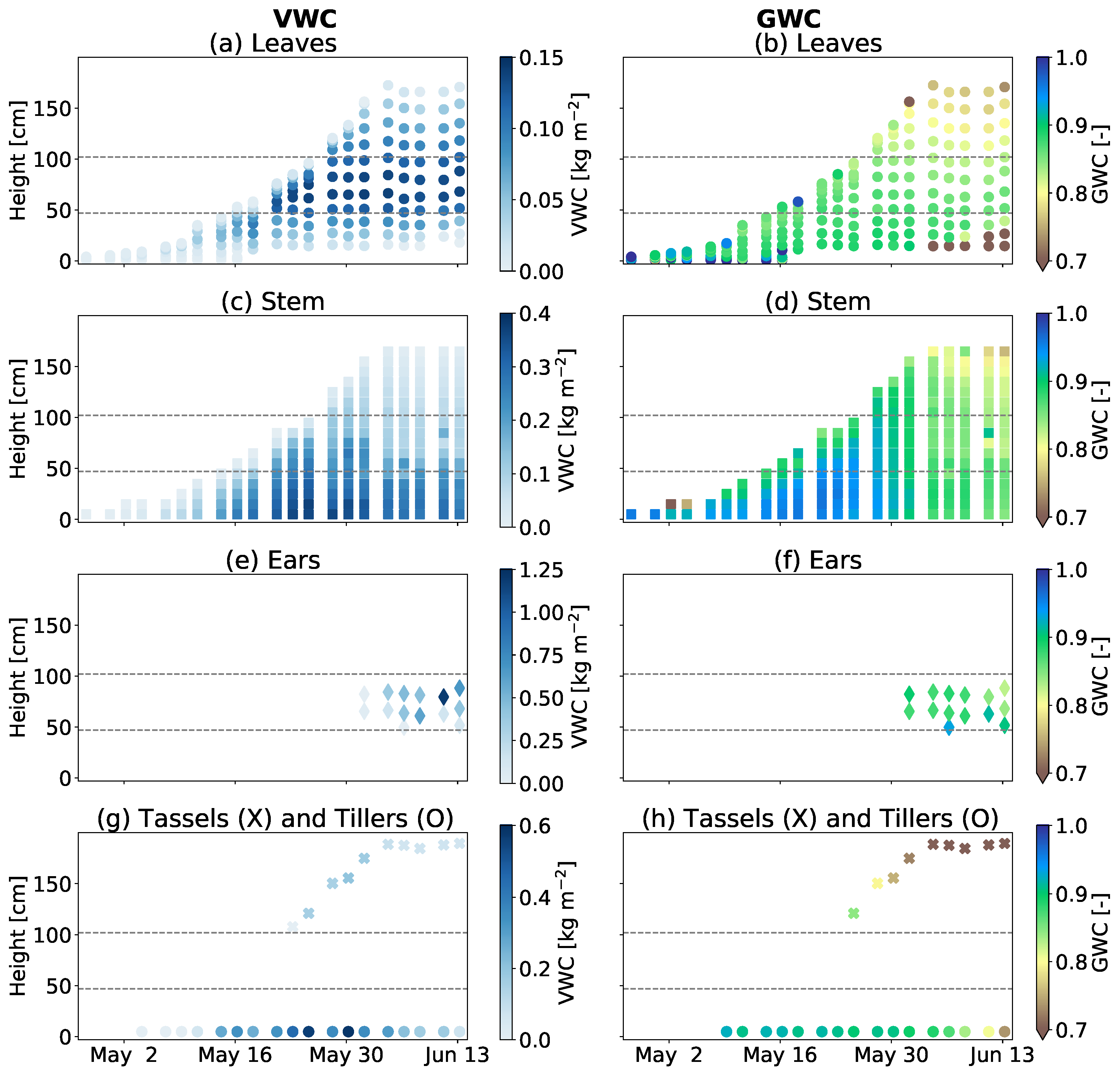

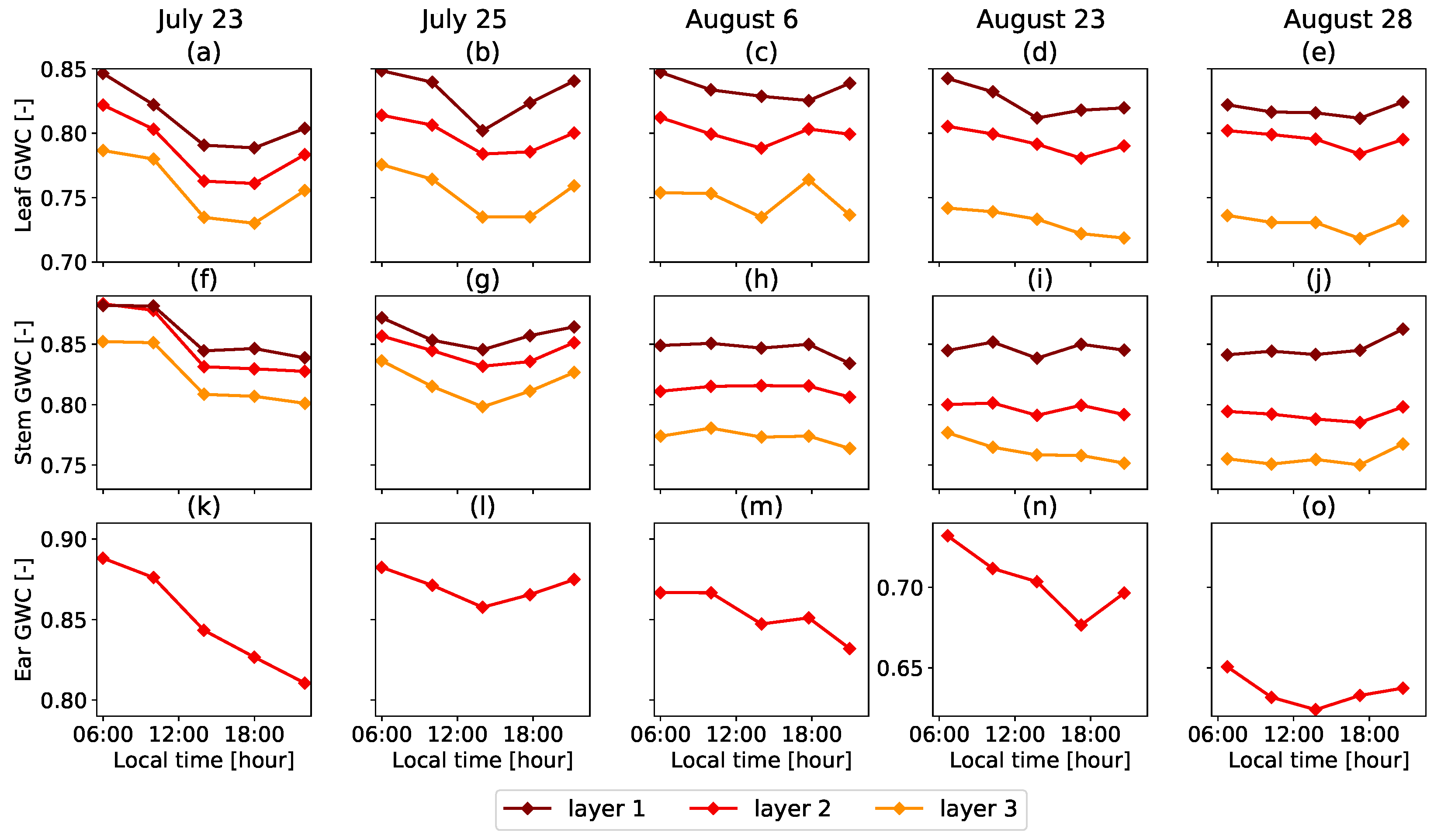
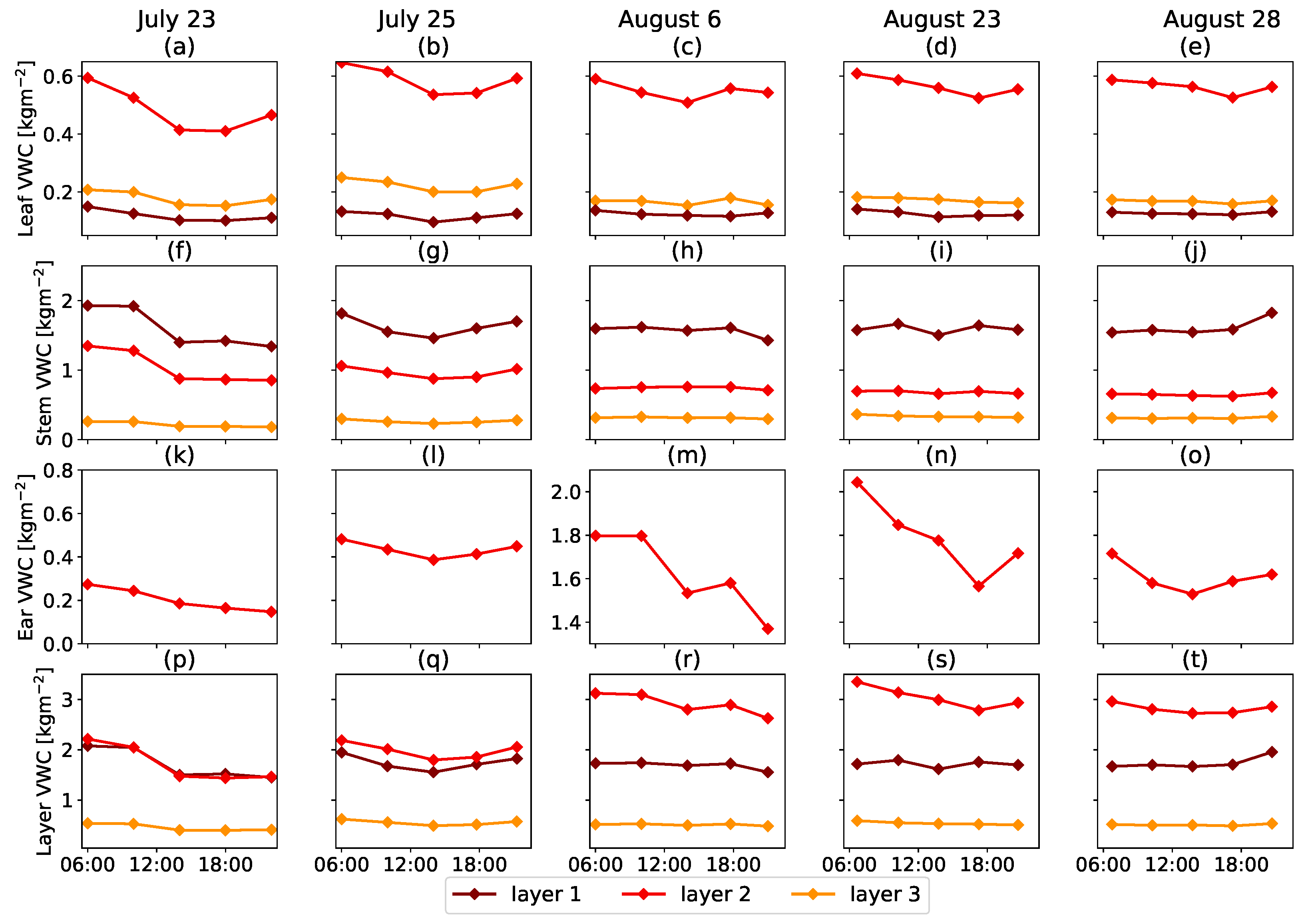


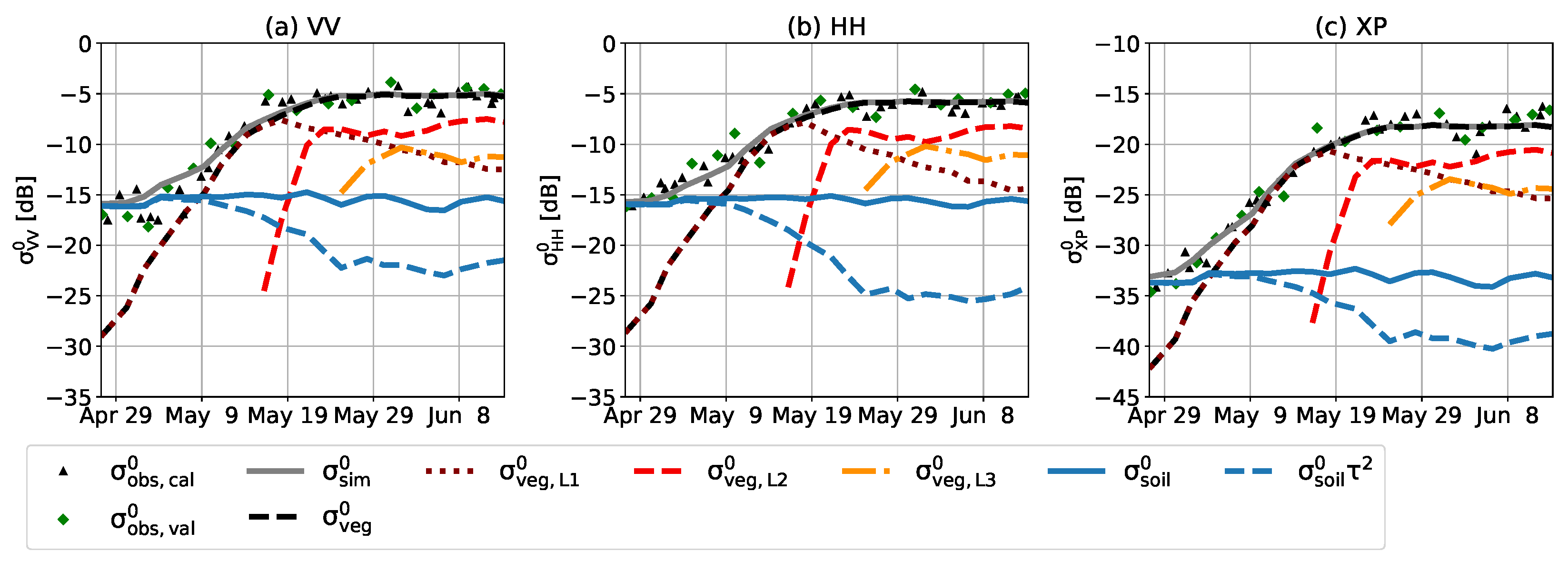




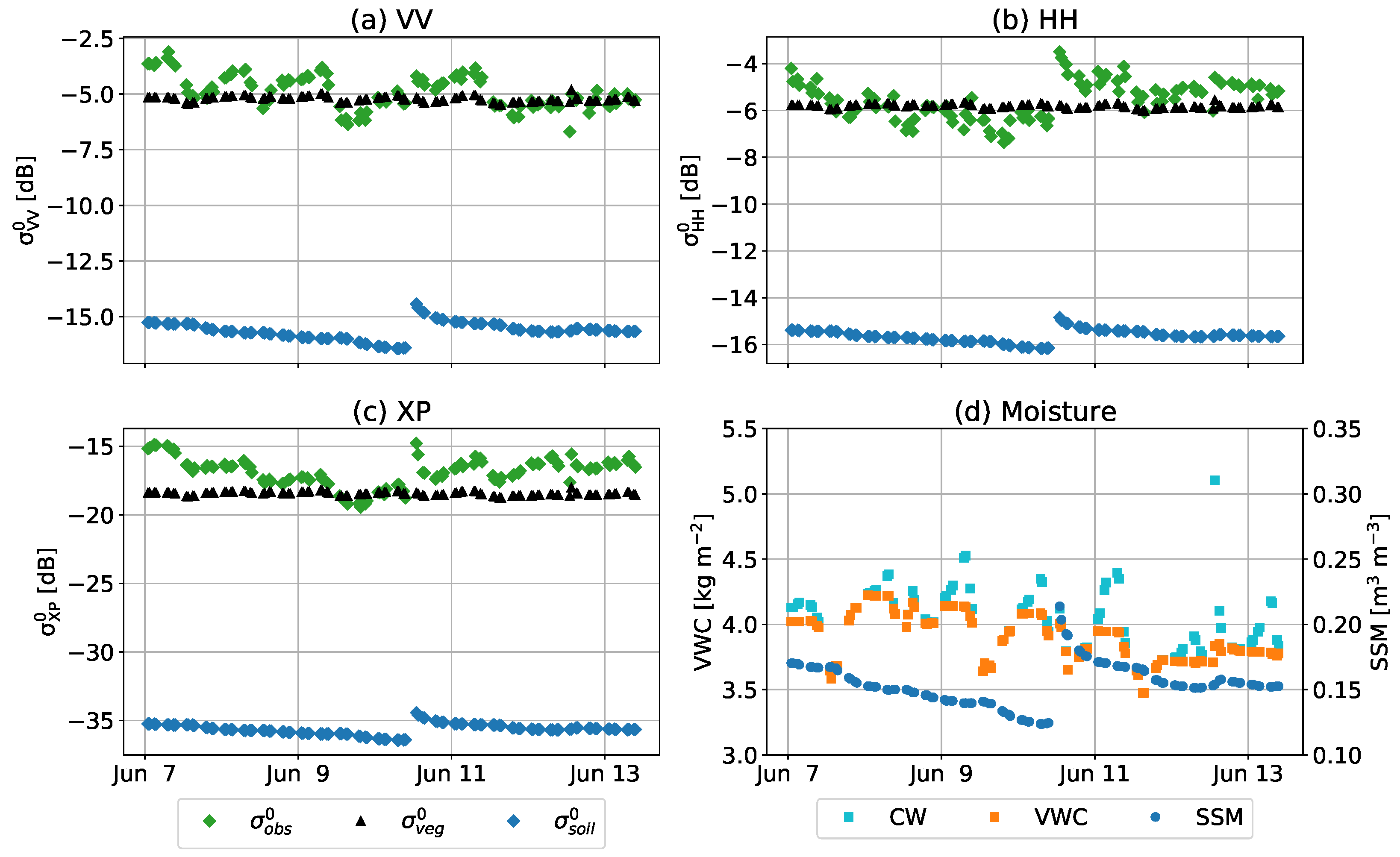
| Citra (2018) | Reusel (2019) | |
|---|---|---|
| Type of corn | sweet corn | field corn |
| Length of season | 66 days | 148 days |
| Plant density | 7.9 plants m | 8 plants m |
| Peak dry biomass | 0.85 kg m | 2.0 kg m |
| Peak VWC | 4.5 kg m | 6.4 kg m |
| Max. height | 210 cm | 275 cm |
| Type of soil | >90% sand | sandy soil |
| Climate | humid subtropical | temperate maritime |
| Parameter | UF-LARS | |
|---|---|---|
| Frequency (GHz) | 1.25 | |
| 3 dB Beamwidth (deg) | E-plane | 14.7 |
| H-plane | 19.7 | |
| Bandwidth (MHz) | 300 | |
| Antenna type | Dual-polarization horn | |
| Range resolution (m) | HH/VV/XP | 8.5/6.2/6.2 |
| Azimuth resolution (m) | HH/VV/XP | 4.7/6.4/4.7 |
| NE (dB) | HH/VV/XP | −23.43/−25.58/−48.12 |
| Error in (dB) | Systematic | 1.49 |
| Random | 0.85 | |
| Incidence angle (deg) | 40 | |
| Platform height (m) | 14 |
| C | D | RMSE [dB] | ||||||
|---|---|---|---|---|---|---|---|---|
| VV | HH | XP | VV | HH | XP | VV | HH | XP |
| 0.51 | 0.39 | 0.026 | 0.14 | 0.20 | 0.13 | 1.22 | 1.28 | 1.24 |
Publisher’s Note: MDPI stays neutral with regard to jurisdictional claims in published maps and institutional affiliations. |
© 2022 by the authors. Licensee MDPI, Basel, Switzerland. This article is an open access article distributed under the terms and conditions of the Creative Commons Attribution (CC BY) license (https://creativecommons.org/licenses/by/4.0/).
Share and Cite
Vermunt, P.C.; Steele-Dunne, S.C.; Khabbazan, S.; Kumar, V.; Judge, J. Towards Understanding the Influence of Vertical Water Distribution on Radar Backscatter from Vegetation Using a Multi-Layer Water Cloud Model. Remote Sens. 2022, 14, 3867. https://doi.org/10.3390/rs14163867
Vermunt PC, Steele-Dunne SC, Khabbazan S, Kumar V, Judge J. Towards Understanding the Influence of Vertical Water Distribution on Radar Backscatter from Vegetation Using a Multi-Layer Water Cloud Model. Remote Sensing. 2022; 14(16):3867. https://doi.org/10.3390/rs14163867
Chicago/Turabian StyleVermunt, Paul C., Susan C. Steele-Dunne, Saeed Khabbazan, Vineet Kumar, and Jasmeet Judge. 2022. "Towards Understanding the Influence of Vertical Water Distribution on Radar Backscatter from Vegetation Using a Multi-Layer Water Cloud Model" Remote Sensing 14, no. 16: 3867. https://doi.org/10.3390/rs14163867
APA StyleVermunt, P. C., Steele-Dunne, S. C., Khabbazan, S., Kumar, V., & Judge, J. (2022). Towards Understanding the Influence of Vertical Water Distribution on Radar Backscatter from Vegetation Using a Multi-Layer Water Cloud Model. Remote Sensing, 14(16), 3867. https://doi.org/10.3390/rs14163867






